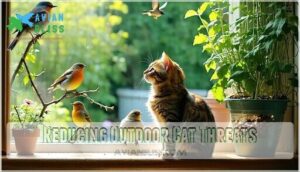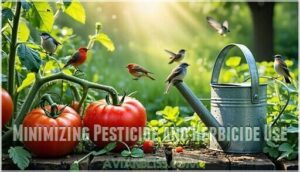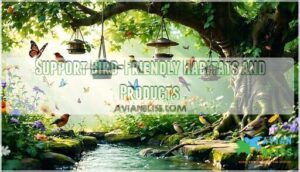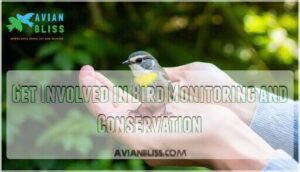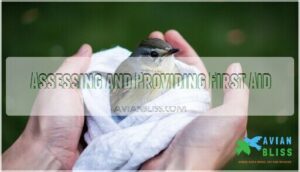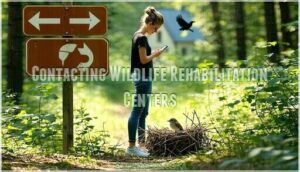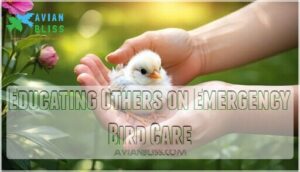This site is supported by our readers. We may earn a commission, at no cost to you, if you purchase through links.
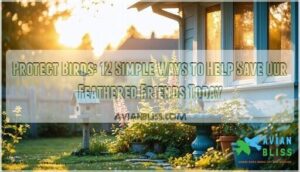 You can protect birds right now by tackling the three biggest killers: window collisions, outdoor cats, and habitat loss. Start simple—apply film to your windows, keep cats indoors, and swap some lawn for native plants. Skip the pesticides and choose shade-grown coffee when you shop.
You can protect birds right now by tackling the three biggest killers: window collisions, outdoor cats, and habitat loss. Start simple—apply film to your windows, keep cats indoors, and swap some lawn for native plants. Skip the pesticides and choose shade-grown coffee when you shop.
Join citizen science projects like eBird to turn your backyard birdwatching into real conservation data. Even small changes pack a punch when millions of people make them. Think of it as giving birds a fighting chance in a world that’s gotten pretty tough for our feathered friends. The specific tricks that work best might surprise you.
Table Of Contents
- Key Takeaways
- Make Your Home Safer for Birds
- Support Bird-Friendly Habitats and Products
- Get Involved in Bird Monitoring and Conservation
- Advocate for Bird-Safe Policies and Communities
- Help Injured or Distressed Birds Responsibly
- Frequently Asked Questions (FAQs)
- How do you protect an injured bird?
- What really scares birds away?
- What is the best method for restraining wild birds?
- How do you protect birds from prey?
- How can I save birds from window collisions?
- Can birds see ultraviolet light on windows?
- How do I stop birds from hitting my windows?
- What causes birds to fly into windows at night?
- Can I use netting to prevent bird window collisions?
- What time of year do birds migrate most?
- Conclusion
Key Takeaways
- Make your home bird-safe by applying window films or decals to prevent deadly collisions, keeping cats indoors (they kill 2.4 billion birds yearly), and replacing lawn areas with native plants that provide natural food and shelter.
- Choose bird-friendly products like shade-grown coffee and cocoa, which support farms that host triple the bird species compared to sun-grown alternatives, and look for Smithsonian Bird Friendly certification when shopping.
- Join citizen science projects like eBird or Project FeederWatch to turn your backyard birdwatching into valuable conservation data that helps researchers track populations and guide protection efforts.
- Advocate locally by supporting bird-safe building codes in your community, attending city planning meetings to promote green spaces, and educating neighbors about simple actions that protect birds from urban hazards.
Make Your Home Safer for Birds
Your home can become a bird sanctuary with just a few simple changes that protect our feathered friends from common household hazards. By addressing window collisions, outdoor cats, toxic chemicals, and habitat needs, you’ll transform your property into a safe haven that nurtures local bird populations year-round.
Preventing Window Collisions
With reflective surfaces acting like invisible barriers, you can protect against deadly collisions by disrupting Glass Visibility through Film Application or External Screens. Position markers 2-4 inches apart on exterior surfaces for Reflection Reduction.
Interior Changes like vertical blinds help too, protecting your local bird community and ensuring public safety around your home. You can find a variety of options for effective bird deterrent films.
Reducing Outdoor Cat Threats
Beyond window strikes lies another major threat: outdoor cats kill approximately 2.4 billion birds every year in the U.S. alone. Cat Predation Impact devastates vulnerable populations, despite TNR Effectiveness requiring unrealistic 75% sterilization rates. One study highlights that cats kill billions of birds annually. Protecting birds means Responsible Cat Ownership through indoor living.
- Keep cats indoors or in enclosed catios
- Use colorful collars that reduce kills by 54%
- Support Cat Curfew Laws in your community
Minimizing Pesticide and Herbicide Use
Through careful pesticide alternatives and herbicide reduction, you’ll protect birds from toxic exposure. Organic gardening methods safeguard vulnerable populations like ground-feeding species.
When you must apply chemicals, choose safe application techniques during non-breeding seasons. Implementing integrated pest management can further reduce chemical use.
Your commitment to ecosystem health and protecting public health creates a bird-friendly haven that fosters thriving wildlife communities.
Installing Bird-Safe Nesting Areas
Beyond reducing chemicals, you’ll protect the area by creating safe nesting spots. Birds need shelter that protects them from predators and weather.
- Choose proper nesting box design with entrance holes sized for target species
- Select durable material selection like cedar or recycled plastic for longevity
- Apply smart placement strategies – mount 5-15 feet high facing away from prevailing winds
- Add predator protection with baffles or smooth mounting poles
- Follow a maintenance schedule – clean boxes annually after breeding season
Consider exploring various nesting box options for different bird species.
Support Bird-Friendly Habitats and Products
Your everyday choices can create powerful ripples that protect millions of birds across their migration routes and breeding grounds. When you choose shade-grown coffee or plant native oak trees in your yard, you’re basically building a network of bird-friendly pit stops that researchers have tracked from backyard feeders to tropical rainforests.
Planting Native Trees and Shrubs
Native Plant Selection creates a foundation that’ll protect local bird species year-round. You’re basically building habitat connectivity when you choose indigenous trees and shrubs over exotic varieties.
These plants naturally support Local Ecosystem Support by providing familiar food sources and nesting materials. Native vegetation also offers Carbon Sequestration benefits while requiring minimal Long-Term Maintenance.
Your yard becomes protected areas that safeguard and shield migrating birds.
Choosing Shade-Grown Coffee and Cocoa
Your morning coffee can protect bird habitat while supporting sustainable farming. Shade-grown coffee farms host over 240 bird species—triple that of sun farms.
When you choose shade-grown cocoa and coffee, you’re backing forest conservation and ethical consumption. These consumer choices protect their people through better farming practices while safeguarding protected areas that birds desperately need.
A recent study highlights how agroforests help biodiversity by providing essential habitats.
Supporting Certified Bird-Friendly Products
Smart shoppers increasingly recognize that certification standards drive meaningful habitat preservation. When you choose products with the Smithsonian Bird Friendly label, you’re supporting sustainable agriculture that protects critical bird habitats. Your ethical consumption directly funds farms maintaining diverse canopy cover. Planting native trees can further augment these efforts.
- Look for Bird Friendly coffee and cocoa at grocery stores and cafes
- Check product packaging for official Smithsonian certification logos
- Ask retailers about stocking certified options to boost consumer awareness
Reducing Lawn Space for Wildlife Diversity
Your sprawling lawn might look neat, but it’s basically a green desert for birds. Replace sections with Native Plantings and Pollinator Gardens to create Habitat Corridors.
These Lawn Alternatives provide Ecosystem Services that protect bird populations while protecting your property value. Even small changes help—birds need diverse landscapes, not endless grass monocultures.
Get Involved in Bird Monitoring and Conservation
You’ll become a vital part of the scientific community by contributing real data that researchers use to track bird populations and guide conservation decisions. Whether you’re counting birds in your backyard for eBird or joining a local Audubon chapter’s habitat restoration project, your observations help scientists understand which species need the most urgent protection.
Participating in Citizen Science Projects
You don’t need binoculars or field experience to protect birds through citizen science. Projects like eBird and Project FeederWatch use community collaboration to gather data collection methods that safeguard species.
Your observations become scientific contributions through project data analysis, while skill development grows naturally.
These programs protect public health by tracking disease patterns and serve customer interest through accessible training materials.
Using Birding Apps for Reporting Sightings
When you download apps like eBird or Merlin Bird ID, you’re joining a global team that helps protect our feathered friends. These platforms transform casual sightings into scientific data that directly guides conservation efforts. App Accuracy improves through rigorous verification processes, while strong data privacy policies safeguard your information. You can find birding app accessories to augment your experience.
Your reports help defend critical habitats and shield vulnerable species from decline:
- Track migration patterns to protect flyway corridors
- Monitor population trends for endangered species recovery
- Identify biodiversity hotspots needing immediate conservation action
- Document climate change impacts on bird behavior and distribution
Joining Local Conservation Groups
Local conservation groups offer group benefits that enhance your individual efforts. You’ll gain skill-sharing opportunities with experienced birders and researchers while creating meaningful local impact.
These organizations provide advocacy opportunities to protect habitats and influence policy decisions. Community building happens naturally as you work alongside neighbors who share your passion.
Conservation groups help protect themselves by building stronger networks, ensuring their protective nature extends beyond individual efforts while protecting against habitat loss through collective action.
Tracking and Reporting Bird Populations
Beyond group efforts, tracking individual bird movements helps scientists understand Population Estimation Methods and Migration Pattern Analysis. Your protected data contributes to Habitat Use Tracking databases.
These Long-term Trend Monitoring systems help researchers spot concerning patterns. While Data Standardization Issues exist, every report helps protect vulnerable species through thorough data processing.
Advocate for Bird-Safe Policies and Communities
You can’t just love birds from your backyard – you need to speak up for them in city halls, planning meetings, and community forums where decisions get made.
When you advocate for bird-safe building codes and green spaces, you’re fighting for the 3 billion birds we’ve lost since 1970, one policy victory at a time.
Supporting Bird-Safe Building Legislation
You can shield birds by advocating for building codes that protect the public from preventable bird deaths. **Over 20 cities now enforce legislation requiring bird-safe materials in new construction.
**
Policy effectiveness hinges on community support—enforcement challenges arise when safeguard measures lack funding. **Contact your representatives to promote bird-friendly ordinances that truly protect protected species citywide.
Engaging With Local Authorities
Why not partner with city planners who already safeguard neighborhoods? Build Community Partnerships by attending public meetings where Zoning Regulations get hammered out.
You’ll protect the public interest while discovering Funding Opportunities. Policy Advocacy works best when you’re the friendly face helping officials understand how bird-safe measures shield wildlife and communities alike through strategic Habitat Protection initiatives.
Promoting Urban Habitat Restoration
Transform your neighborhood by advocating for green infrastructure projects that protect birds from urban hazards. Community gardens with native planting create essential stopover sites, while brownfield redevelopment opportunities can safeguard urban biodiversity.
Push for projects that shield birds from danger—turning vacant lots into protected habitats helps restore what development took away.
Raising Community Awareness
You can’t protect a child from danger without teaching them to recognize it first. The same principle applies to birds. Organize Community Bird Walks to help neighbors spot local species and threats. Host Educational Workshops at libraries or community centers, covering simple ways to safeguard birds. Launch Social Media Campaigns sharing bird-friendly tips.
Consider supporting efforts to address habitat loss and degradation. Partner with School Programs to teach kids about protecting them through habitat preservation and responsible pet ownership.
Help Injured or Distressed Birds Responsibly
When you encounter an injured bird, your first instinct might be to help, but knowing the right approach can mean the difference between rescue and unintended harm.
You’ll need to assess the situation carefully and contact wildlife rehabilitation experts who have the training to provide proper medical care and increase the bird’s chances of survival.
Assessing and Providing First Aid
Finding an injured bird can feel overwhelming, but quick Injury Assessment saves lives. Look for obvious wounds, bleeding, or unusual positioning before handling.
Use gentle Handling Techniques—wrap the bird in a towel to protect from danger while you examine it. Clean visible injuries with saline for basic Wound Care, then focus on Stabilization Methods like keeping the bird warm and quiet to protect the patient during recovery.
Contacting Wildlife Rehabilitation Centers
Once you’ve assessed the bird’s condition, you’ll need professional help. Finding the right wildlife rehabilitation center can feel overwhelming, but these steps will guide you through the process:
- Call Animal Help Now or check your state’s game department directory for licensed centers
- Prepare essential details: location found, visible injuries, timeline, and any pet contact
- Ask about center licensing, transportation logistics, and their euthanasia policies upfront
- Inquire about volunteer opportunities to support their mission long-term
Most centers operate 9AM-4PM but offer emergency guidance around the clock to protect birds from danger.
Safely Releasing Recovered Birds
Once professionals clear a bird for release, timing becomes everything. You’ll want to defend your feathered patient from unnecessary stress through proper release site selection—ideally returning them where they were found.
Early morning releases for diurnal species protect from predators and allow daylight acclimation strategies to work. Remember to think about if the bird is a nestling or fledgling when choosing a release spot.
Monitor post-release activity to guard against complications and make certain your rescued bird thrives.
Educating Others on Emergency Bird Care
Share your knowledge about orphaned nestlings and bird trauma with friends and family. Teaching proper species identification helps others protect birds from danger more effectively.
Point them to rehabilitation resources when they find injured wildlife. Demonstrating safe handling techniques can prevent further harm during rescue attempts.
Your guidance helps defend vulnerable birds throughout your community.
Frequently Asked Questions (FAQs)
How do you protect an injured bird?
Like a fragile ship seeking harbor in a storm, you’ll gently capture the bird with a towel, place it in a dark, ventilated box, and contact wildlife rehabilitators immediately—don’t attempt feeding or watering.
What really scares birds away?
Sudden movements and noise spook most birds, but natural predators are the most effective deterrents. Flashing reflective surfaces, decoy owls, and laser beams trigger their flight response instantly.
You’ll find success combining multiple scare tactics for persistent results.
What is the best method for restraining wild birds?
The towel method works best for restraining wild birds safely. You’ll wrap the bird gently but firmly, keeping wings secure while leaving the head exposed for breathing.
This technique protects both you and the bird during handling.
How do you protect birds from prey?
You’ll need to create physical barriers around nesting areas. Install predator guards on poles, use mesh wire around ground nests, and maintain dense shrub cover where possible.
How can I save birds from window collisions?
Place decals or screens on windows to break up reflective surfaces. You can also move feeders closer than three feet or farther than thirty feet from glass.
Can birds see ultraviolet light on windows?
Before telephone wires, you’d wonder how swallows avoided invisible barriers.
Most birds can see ultraviolet patterns on specially-treated windows, but this superpower doesn’t work for all species – mainly small songbirds and gulls can spot UV markers.
How do I stop birds from hitting my windows?
Apply decals or tape to glass surfaces—birds can’t see clear barriers. You’ll create visible patterns they’ll avoid while maintaining your view.
Window feeders also redirect flight paths away from dangerous collisions.
What causes birds to fly into windows at night?
Artificial lights confuse migrating birds at night, disrupting their natural navigation systems. They attract migrating birds into urban landscapes, especially in low-ceiling or foggy conditions.
You’ll see more window strikes after birds get lured off-course.
Can I use netting to prevent bird window collisions?
Yes, netting works brilliantly! Install it inches away from your window—tight enough that birds bounce off safely rather than reaching the glass. Keep openings under ½ inch for maximum effectiveness.
What time of year do birds migrate most?
You’ll see spring migration from March to mid-June and fall migration from mid-August to November. Peak activity happens in late April through May for spring and mid-August to mid-October for fall.
Conclusion
Research shows that cats kill between 1.3-4 billion birds annually in North America alone—making your efforts to protect birds more critical than ever. These twelve strategies aren’t just feel-good actions; they’re scientifically-backed solutions that work.
You don’t need to implement everything at once. Start with one or two methods that fit your lifestyle, whether it’s adding window decals or switching your coffee brand.
Your backyard can become a conservation success story. Small actions multiply when neighbors join in, creating corridors of safety that give birds the fighting chance they desperately need in our changing world.
- https://news.cornell.edu/stories/2025/05/north-american-bird-populations-suffering-severe-decline
- https://www.ducks.org/newsroom/us-bird-populations-continue-alarming-decline-new-report-finds
- https://www.birdwatchingdaily.com/news/conservation/state-of-the-birds-2025-report-shows-america-is-still-losing-birds/
- https://abcbirds.org/news/2025-state-of-the-birds/
- https://www.birdfy.com/blogs/blogs/endangered-birds-list-2025-and-how-to-help


